|
INTRODUCTION
The purpose of this book is to introduce the public to the town of
Moira and to relate something of it's historic origins. The history of the
Parish Church and the town has been traced over the past four hundred
years. Not only is it intended to be a short history of the town and
Parish but a handbook giving significant information.
It is hoped that these chapters will give some indication of the progress
of Moira and it's development through the years.
The event of the Flower Festival seemed to be the most appropriate time
for such a handbook to be introduced. As you will see from the early
chapters the gardens of Moira were the foremost centre in Europe for the
propogating of tropical plants from the other side of the world.
Throughout this short historical outline we are reminded of the Christian
witness of the Church. The spire of the Church, which can be seen for
miles is a well known landmark. It points heavenward and is a constant
reminder of those who have worshipped and witnessed in times past. Let us
pray that this witness will continue both now and in the furture.
"One is nearer God's heart in a Garden, than anywhere else on earth". I am indebted to Mr. William Best for his excellent photographs and to
Mrs. Janice Lightowler for designing the front cover. To Mr. Trevor Neill
and Mr. Holt McCullough I extend my grateful thanks for relevant
information, and to Plantation Press for printing this handbook. Finally
to my wife Rosemary for typing the manuscript and preparing it for
publication. Robert Rudd (Rector)
�Top
Chapter 1
Early History
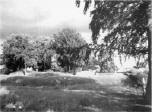 In all probability the
origin of the name Moira (the Plain of the Ring Forts) has been anglicised
from the original Irish Magh Rath. From which of the many raths or forts
in the district it derives it's title is a manner of uncertainty. Perhaps
the best preserved example to be seen is the "Rough Fort" on the Old
Kilmore Road in the townland of Risk. Near where Waringfield
House once stood is "Pretty Mary's Fort". In all probability the
origin of the name Moira (the Plain of the Ring Forts) has been anglicised
from the original Irish Magh Rath. From which of the many raths or forts
in the district it derives it's title is a manner of uncertainty. Perhaps
the best preserved example to be seen is the "Rough Fort" on the Old
Kilmore Road in the townland of Risk. Near where Waringfield
House once stood is "Pretty Mary's Fort". The Green in front
of the houses at Claremont is all that is left of another of
these ring forts. The earliest known record is of a battle
that was fought at Moira in 637 A.D. between Domhnall
(pronounced Donall), High King of Ireland and Congal, King of
Ulster. This conflict is described as one of the most
sanguinary in early Irish History. Congal had previously
killed Domhnall's predecessor and had fled to Britain and
returned after nine years with an army of Britons, Scots and
Saxons, including a Scottish King and a number of Princes.
Domhnall advanced from Tara, with an army of Irish chieftains
and princes. The two armies came together at Moira and
Congal's army was annihilated. Congal himself was slain as
also were a number of the Scottish Princes. This battle is
the subject of an epic poem written by Sir Samuel Ferguson in
1872. It is also recorded in the writings of the famous
historian Adaman - an eighth century historian who wrote about
the life of St.Columba. Records show that the routed armies
fled over the Ford Ath-ornagh (Thornford or Thornbrook), up
the ascent of Trummery, and in the direction of the Killultagh
Woods, near Ballinderry. When excavations took place in the
construction of the line of the Ulster Railway (which passes
close below the Old Church of Trummery) great quantities of
bones were discovered believed to have been those of men and
horses killed in the battle. Some of the names of the
townlands in the area originate from the Battle - particularly
Aughnafosker, which means the 'field of slaughter' and
Carnalbanagh - the' Scotsman's grave'. In this townland,
according to tradition there used to be a pillar stone with a
crude cross and some circles on it signifying the graves of
the Scottish Princes. Accompanying Domhall's army was a Bishop
called Saint Ronan Finn, who is reputed to have established a
monastery and/or a nunnery in the area. His memory is still
preserved in the townland of Kilminiogue - the 'Church of my
dear young Finn'. There are still the remains of an ancient
graveyard in the townland and it has been said that the
outline of the church can be seen from the air. Some of the
local people claim that Kilminiogue means 'the Church of the
young Maidens'. This seems possible - as the Irish translation
(Cill na mna og) would support the theory that the monastic
establishment may have been included a nunnery. When the
present Church of Moira was built in 1723, it was originally
to have been called St.Inn's (an aspirated form of Finn)
though when it was consecrated it was anglicised to St john's.
Ronan Finn was also associated with Magheralin where there was
a seventh century monastery or a nunnery. There is still a
lane known as the 'Nun's Walk'. The name Magheralin is derived
from Maghera Clon - which means the 'Plain of the Church'.
It's ancient name was Lann Ronan Finn, the Church of Ronan
Finn. Bishop Reeves, a nineteenth century historian identified
Magheralin with an ancient monastery called Linduachail
founded in the seventh century. The historian Rev. J.B.
Leslie, however, disputes this fact and locates Linduachail in
the Parish of Kilsaran, Co. Louth, in the region around
Dundalk.
�Top
Chapter 2
The Castle and The Rawdon
Family For the next thousand years after the
Battle of Moira, little or nothing is to be found in the
records. In medieval times the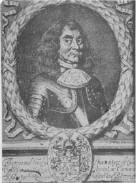 district belonged to the O'Lavery Clan, a derivation of this
name is still very prominent in the area. When the Rebellion
of 1641 took place, the lands belonging to many of the
insurging families were confiscated, because of their
involvement in the uprising. Among these families were the
O'Laverys, who inhabited the South West region of Co. Antrim.
After the Rebellion, Ulster was planted with families from
many parts of England and thus began the Plantation of Ulster.
district belonged to the O'Lavery Clan, a derivation of this
name is still very prominent in the area. When the Rebellion
of 1641 took place, the lands belonging to many of the
insurging families were confiscated, because of their
involvement in the uprising. Among these families were the
O'Laverys, who inhabited the South West region of Co. Antrim.
After the Rebellion, Ulster was planted with families from
many parts of England and thus began the Plantation of Ulster.
In 1631 Major George Rawdon, whose family owned Rawdon Hall
near Leeds in West Yorkshire, came to live in the area. He was
appointed to manage the Estate of Viscount Conway, Lord
Lieutenant of Co. Antrim, at Killultagh near Ballinderry.
His ancestors had fought at the Battle of Hastings. His first
wife was Ursula Hill, widow of Francis Hill of Hillhall. She
died in 1641. It was George Rawdon who built the Garrison at
Aghalee, commonly known as Soldierstown. In the Rebellion the
armies of Sir Phelim O'Neill had massacred 40,000 Protestants.
George Rawdon, with an army of 200 Englishmen completely
repulsed O'Neill's army at the Battle of Lisburn. In 1651,
ten years after the Rebellion, Major de Burgh, who was
quartered at Charlmont Fort, near Moy in Co. Tyrone, built a
brick house at Moira in Co. Down. Major Rawdon, who had been a
military commander in the defence of Lisnagarvey- (the old
name for Lisburn) replaced de Burgh as owner of the mansion
and estate at Moira. Previously he had lived at Brook Hill
near Ballinderry. Shortly after acquiring Moira Castle he
married the daughter of the second ViscountConway. He was to
give fifty years of faithful service to the Conway family,
serving successively three Viscounts. The third Viscount was
created Earl of Conway and died in 1683.
�Top
When George Rawdon acquired Moira and other estates in Ireland
he established a dynasty similar to that of the Hill family of
Hillsborough who became the Marquises of Downshire. Later his
own descendants were to marry into the Hill family who were
among the richest landowners in the country, and were reputed
to own land in almost every county in Ireland. He was created
a Baronet in 1665. He had done much to foster the early growth
and development of Lisburn after the Rebellion. It was his
family who were largely responsible for the Moira we know
today. He was known as the "Great Highwayman", as he was
responsible for constructing many of the highways in the
country. He was a very close friend of the famous Bishop
Jeremy Taylor who was Bishop of Down, Connor and Dromore who
for a short time lived in Magheralin, a few miles from Moira.
Sir George Rawdon's wife Dorothy died in 1665 and was buried
in the chancel of Lisburn Cathedral. Sir George Rawdon himself
died in the year 1683 and was also buried in Lisburn
Cathedral. He was succeeded by Sir Arthur Rawdon, who like his
father, was a member of Parliament, and was one of the
Generals in King William of Orange's Armies. When King William
landed in Ireland Rawdon raised troops and rallied to his
side. Before
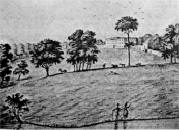 long
he was besieged in Derry, where he became ill, but, encouraged
by his friends, he managed to escape, and so ended his part in
military affairs. When Sir Arthur inherited the lands at Moira
he rebuilt the Mansion which became one of the most
magnificent Castles in the country. Records describe this
mansion as a "commodious habitation, surrounded by a wood,
which affords beautiful walks, a large lawn extends in front,
where sheep feed, and is terminated by trees, and a small
Lough eastwards, the rear of the castle grounds contains a
wood, with large opening fronting the castle, which forms a
fine perspective" long
he was besieged in Derry, where he became ill, but, encouraged
by his friends, he managed to escape, and so ended his part in
military affairs. When Sir Arthur inherited the lands at Moira
he rebuilt the Mansion which became one of the most
magnificent Castles in the country. Records describe this
mansion as a "commodious habitation, surrounded by a wood,
which affords beautiful walks, a large lawn extends in front,
where sheep feed, and is terminated by trees, and a small
Lough eastwards, the rear of the castle grounds contains a
wood, with large opening fronting the castle, which forms a
fine perspective" In Ireland, at the end of the seventeenth
century, there was no money to be got for 'anything in the
world'. Tenants were too poor to pay their rents, and
tradesmen were on the verge of ruin, yet it was just at this
time that a young Irish landlord, called Sir Arthur Rawdon,
began to garden on a scale hitherto unknown. Sir Arthur Rawdon
was called the 'Father of Irish Gardening' and was also known
as 'The Cock of the North'. He was a contemporary of Sir Hans
Sloane, (who also came from Co. Down) and was a great
botanist. Sloane had a great influence on Sir Arthur's
horticultural tastes. In 1687 Sloane went to the West Indies
and kept up a correspondence with Sir Arthur keeping him
informed of the various seeds and plant life there. He studied
the natural history of the islands and later brought home to
England at least 800 different species and plants. In 1690,
Rawdon went to England and, after seeing Sloane's plants, he
wrote asking him for seeds. A month later he received 400
different species with instructions on how to grow them. At
this time Rawdon engaged James Harlow to go to Jamaica to
bring back plants for Moira.
�Top
In his estate at Moira, Sir Arthur built the first hot-house
in Europe. According to Bassett's History of Co. Down, frogs
were first discovered in Ireland at Moira, probably in the
magnificent botanical gardens. These gardens were adorned with
a pretty Labrynth, ponds, canals and woods. The trees included
the Locust of Virginia, a tree 30ft high, and of a trunk at
least a foot and a half in diameter, bearing a pod longer than
any pea, and full of honey, supposed to be the food that Saint
John the Baptist lived on in the wilderness. The Ucca or
Adam's needle, which has a leaf like a flag, and a point as
sharp as a needle. Another was the Indian Honeysuckle, spired
like a rocket, with a crimson coloured flower. In Lisburn Lord
Hertford had beautiful hanging gardens which were the
inspiration of Sir Arthur Rawdon, and they cascaded from the
present Castle Gardens to the large basin. All that remains
today are the terraces, which are kept by the Borough Council.
Just over twenty years ago they were a wilderness and some
shrubs remained, which may have been part of the original
planting. Sadly enough Sir Arthur lived only a short time to
enjoy that garden he created and loved, for he died in 1695 at
the early age of thirty-four. It is worth noting that for two
generations Rawdon's descendants maintained the garden though
the' stove' (hot-house) was pulled down, but when in 1788,
Moira passed into other hands, the garden was neglected and
subsequently vandalised. By the middle of the next century
there were scarcely any trees of note. Now nothing remains of
either house or garden, save for a few banks.
 Sir
Arthur's successor, Sir John, the Third Baronet, was born in
1690 and died in 1723. Throughout his short life he had much
ill health, owing to tuberculosis. At the time of his death
St. John's Church in Moira had just been consecrated. He was
buried in the family vault underneath the Church. Sir Hans
Sloane encouraged Sir John to correspond and in 1711, in
response to a letter from Sloane enquiring about the plants at
Moira, John Rawdon replied that owing to the 'carelessness of
servants and the death of Mr. Harlow most of the plants were
withered to nothing'. Outside, however, the trees and shrubs
fared better. His son, also Sir John, inherited the estates
and the Baronetcy at the age of three. Sir
Arthur's successor, Sir John, the Third Baronet, was born in
1690 and died in 1723. Throughout his short life he had much
ill health, owing to tuberculosis. At the time of his death
St. John's Church in Moira had just been consecrated. He was
buried in the family vault underneath the Church. Sir Hans
Sloane encouraged Sir John to correspond and in 1711, in
response to a letter from Sloane enquiring about the plants at
Moira, John Rawdon replied that owing to the 'carelessness of
servants and the death of Mr. Harlow most of the plants were
withered to nothing'. Outside, however, the trees and shrubs
fared better. His son, also Sir John, inherited the estates
and the Baronetcy at the age of three. This second Sir John,
was later elevated to the peerage as Baron Rawdon and became
Earl of Moira in 1762. This first Earl was a well known figure
in Irish Government circles. Politically he is said to have
been for the uniting of Ireland under it's own rule. When he
died in 1793 his funeral was said to have been the largest
ever seen in Ireland. Over four hundred horse-drawn carriages
were in the procession from all parts of the country. He too
was buried in the family vault in St. John's, Moira.
�Top
This first Earl was married three times. His first wife, a
daughter of the Earl of Egmont, died five years after their
marriage - they had two daughters. She is believed to have
been buried in Scotland. In 1746 he married Anne Hill, sister
of the Marquis of Downshire. She died in 1751 without having a
family, and was buried in the family vault. She is said to be
the Lady Moira who was reputed to haunt Moira Demesne. The
third Lady Moira, was Lady Elizabeth Hastings, daughter of the
ninth Earl of Huntingdon. Her mother was a famous disciple of
John Wesley, and was the foundress of the Methodist sect known
as the Countess of Huntingdon's Connection, as will be seen in
a later chapter. There were eleven children of this marriage,
five of whom died very young. Lady Elizabeth's family owned
extensive estates throughout England which she now inherited,
including the well known Castle Donnington in Leicestershire.
During the Industrial Revolution a small village was built in
Leicestershire, called Moira, near Ashby de La Zouch, which is
today a busy industrial village in the East Midlands. This
Lady Moira died in 1808 and was buried at Newtownforbes in
County Longford where one of her daughters was married to the
Earl of Granard whose seat was at Newtownforbes. There is a
house in County Longford near Newtownforbes, marked in the
Ordinance Survey maps as Carrickmoyra House, and there was
also a parish of Moira, in the Diocese of Ardagh.
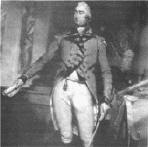 The
second Earl, Francis Rawdon Hastings, who took on his mother's
maiden name, inherited his mother's titles as well as his
father's, and al so much of the estates belonging to the
Huntingdon dynasty. He was educated at Harrow and in 1774 went
to America and fought in the American War of Independance, and
was present at the battle of Bunker's Hill. He later became
Adjutant General of the British Armed Forces in America and
during the illness of Lord Cornwallis commanded the armies
that brought victory to the colonists. He is said to have been
one of the most courageous Generals in the whole war. It was
some of his soldiers who founded towns called Moira, in memory
of his exploits. One can be found in New York State, and
another in Canada where there is also a river of the same
name. The
second Earl, Francis Rawdon Hastings, who took on his mother's
maiden name, inherited his mother's titles as well as his
father's, and al so much of the estates belonging to the
Huntingdon dynasty. He was educated at Harrow and in 1774 went
to America and fought in the American War of Independance, and
was present at the battle of Bunker's Hill. He later became
Adjutant General of the British Armed Forces in America and
during the illness of Lord Cornwallis commanded the armies
that brought victory to the colonists. He is said to have been
one of the most courageous Generals in the whole war. It was
some of his soldiers who founded towns called Moira, in memory
of his exploits. One can be found in New York State, and
another in Canada where there is also a river of the same
name.
�Top
One of the bravest corporals was Dennis O'Lavery, who was also
a native of Moira. He is said to have saved Lord Moira from
being killed by cannon fire, and in the annals of the War is
regarded as one of it's greatest heroes. Incidentally, and
ironically, it was the Rawdon family who had confiscated his
family's lands after the Rebellion of 1641. Lord Moira is said
to have built a memorial to O'Lavery in recognition of the
fact that he saved his life, but it's exact location is
uncertain. On his return home, the Earl became a member of
Parliament and was advocate of the Act of Union. He later
became the first Governor General of India and was largely
responsible for the establishing of India as part of the
British Empire. He became Marquis of Hastings in 1817 and
was also a Fellow of the Royal Society. He was later appointed
the first Commander-in-Chief of Malta where he died in 1826
and was buried in Valetta. The last direct descendant, Henry
Rawdon, a great nephew, fourth Marquis of Hastings died
without issue, and thus the Marquisate became extinct. By
1805 the Rawdon family had moved to their other Irish estates
in Ireland, including Montalto at Ballynahinch. The new tenant
of Moira Castle was William Sharman, a member of Grattan's
Parliament, who was very prominent in the history of the area.
He commanded the Moira Volunteers which were a contingent of
the Irish Volunteers. This seems to have been a protection
force in the late eighteenth century. His son, another William
Sharman married a daughter of the Craford family of
Crawfordsburn, and changed his name by deed poll to
Sharman-Crawford. This family owned Moira Castle only for a
relatively short period. At this stage the Castle and
Demesne was purchased by the family of Sir Robert Bateson. He
also owned Belvoir Park in Belfast. The Bateson family did not
live for any permanent period in Moira but used the Castle as
a second residence. His son, Thomas, became the first Baron of
Deramore. There is a plaque in Moira Parish Church to Sir
Robert Bateson and also a family vault is under the obelisk in
the Churchyard. Incidentally there is also a plaque to the
first Lady Deramore in Moira Parish Church, and an identical
plaque is also found in Knockbreda Parish Church in Belfast
with which the family were also connected. The Castle was
demolished early in the nineteenth century but there are still
a few remains of walls in the Demesne - probably of the walled
garden. In the past twenty years the Demesne has been
developed by the Lisburn Borough Council as a public park and
once again it is a great array of beautiful flowers.
�Top
Chapter 3
The Building of St. John's
Church The Parish of Moira was founded in 1721,
having been carved out of the parish of Magheralin. Up to th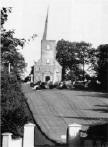 is
period services of worship were held in a "Charity School" -
probably on the same site as the present "Old School". A
portion of ground opposite Moira Castle was given by the Hill
family - later the Marquises of Downshire for the building of
the Church. The entry into the Church grounds and the Castle
drive were in a straight line. The Parish Church was
consecrated in 1723. As has been stated earlier, it was
originally to have been dedicated as St. Inn's, referring to
the Saint who had founded monasteries in the area in the
seventh century. The Rawdon Family contributed much of the
expense in the building of the Church, although Sir John
Rawdon himself died the same year the Church was consecrated.
The first Curate in-Charge was the Rev. Hugh Hill, who seems
to have been a distant relation of the Hill Family. is
period services of worship were held in a "Charity School" -
probably on the same site as the present "Old School". A
portion of ground opposite Moira Castle was given by the Hill
family - later the Marquises of Downshire for the building of
the Church. The entry into the Church grounds and the Castle
drive were in a straight line. The Parish Church was
consecrated in 1723. As has been stated earlier, it was
originally to have been dedicated as St. Inn's, referring to
the Saint who had founded monasteries in the area in the
seventh century. The Rawdon Family contributed much of the
expense in the building of the Church, although Sir John
Rawdon himself died the same year the Church was consecrated.
The first Curate in-Charge was the Rev. Hugh Hill, who seems
to have been a distant relation of the Hill Family. When the
Church was built it had a slate steeple which was blown down
in a freak storm in 1884 and was replaced by the present
copper spire. The interior contained a three-decker pulpit,
consisting of a pulpit, with a Prayer Desk under neath and a
Clerk's desk on the lower level. This was replaced at a later
date. The Reredos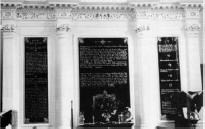 containing the Ten Commandments, Apostle's Creed and the
Lord's Prayer was written on Irish Linen, said to have been
weaved in the area, and is flanked by Corinthian pillars. This
Reredos is reputed to have been a replica of one in the
Rutland Chapel in Battersea, London. The Dukes of Rutland were
related to the Marquises of Downshire. The two boxes at either
side of the West Door were the family pews of the two
principal families - the Rawdon family on the left hand side
and the Waring family on the right. The lower seating in each
of these twoboxes were for the respective family servants. All
the pews on each side of the nave were fitted with a door for
the purpose of keeping out draughts.
containing the Ten Commandments, Apostle's Creed and the
Lord's Prayer was written on Irish Linen, said to have been
weaved in the area, and is flanked by Corinthian pillars. This
Reredos is reputed to have been a replica of one in the
Rutland Chapel in Battersea, London. The Dukes of Rutland were
related to the Marquises of Downshire. The two boxes at either
side of the West Door were the family pews of the two
principal families - the Rawdon family on the left hand side
and the Waring family on the right. The lower seating in each
of these twoboxes were for the respective family servants. All
the pews on each side of the nave were fitted with a door for
the purpose of keeping out draughts. Originally the old font
was in the middle of the Church and was moved to the Waring
pew in the 1940's.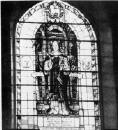 The Communion Rails were the banister rails of Moira Castle
and the West door came from the ballroom of Moira Castle.
There was a stove in the middle of the Church with pipes
underneath the floor and gratings in the nave - this was the
heating system of the Church. There are parts remaining of
candle holders which can be seen on the walls of the Church.
The Communion silver is extremely valuable and some of these
pieces together with a brass Baptismal Ewer were presented to
the Church by the Rev. George Howse, who was first Rector. In
many of the Churches of this period there was no chancel. This
is characteristic of the eighteenth century. In architectural
terms the church is described as barn shaped with a slate
steeple.
The Communion Rails were the banister rails of Moira Castle
and the West door came from the ballroom of Moira Castle.
There was a stove in the middle of the Church with pipes
underneath the floor and gratings in the nave - this was the
heating system of the Church. There are parts remaining of
candle holders which can be seen on the walls of the Church.
The Communion silver is extremely valuable and some of these
pieces together with a brass Baptismal Ewer were presented to
the Church by the Rev. George Howse, who was first Rector. In
many of the Churches of this period there was no chancel. This
is characteristic of the eighteenth century. In architectural
terms the church is described as barn shaped with a slate
steeple. There is reputed to have been a tunnel from Moira
Castle leading to the Church which was used by the Rawdon
family and their servants as their means of entry to the
Church. When sewers and electric cables were laid the tunnel
fell into disuse and ceased to exist. The gallery was not
built until the year 1871.
There is an unconfirmed report that the first Harvest Thanksgiving
services in Ireland were held in Moira Church in 1726 shortly after it was
consecrated. It will be noted that the first harvest service in England
was held in Morwenstow Church in Devon about one hundred and twenty years
later. As early as 1742 repairs were carried out to the Church which
included repairing the windows and making the Church watertight.
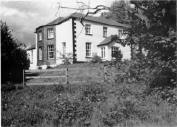 According
to Lewis' Topographical History the Rectory was built in 1799 for the sum
of �710. There is a record however of a glebe house from the time the
Church was built. The present rectory does seem to have been built in
various stages. Above the ceiling of the present kitchen there is a stone
dated 1811 with the name James Hagan (probably the builder or rebuilder of
the wall). There are cellars divided into nine rooms, including a large
kitchen and adjoining rooms for servants. In the late 1930"s the kitchen
was resited from the basement to the ground floor. There is a moat round
the basement, spanned at the back by a ramp to the yard and steps to the
basement and back door. According
to Lewis' Topographical History the Rectory was built in 1799 for the sum
of �710. There is a record however of a glebe house from the time the
Church was built. The present rectory does seem to have been built in
various stages. Above the ceiling of the present kitchen there is a stone
dated 1811 with the name James Hagan (probably the builder or rebuilder of
the wall). There are cellars divided into nine rooms, including a large
kitchen and adjoining rooms for servants. In the late 1930"s the kitchen
was resited from the basement to the ground floor. There is a moat round
the basement, spanned at the back by a ramp to the yard and steps to the
basement and back door. The graveyard like the Church is in the townland
of Clare at the east side of the town. The old registers are
lost but the surviving baptismal and burial registers date
from 1825. many of the headstones, especially at the back of
the graveyard are difficult to decipher, the inscriptions
obliterated by weathering. The area around the church is more
ancient than that of the front. Beside the church is a large
obelisk and vault in memory of Sir Robert Bateson and his
wife. They were the parents of the first Lord Deramore who
became the owners of Moira Castle and Estate. There is also a
vault belonging to the Rawdon family underneath the Church.
There are visible signs on the East wall of the church of what
must have been the entrance to the vault.
There are a number of graves where former Rectors and their families are
buried:- Rev. John Gifford (1728-33); Rev. Thomas Waring (1743-77); Rev.
Andrew Greenfield (1783-88); Rev. John Ffolliott (1883-84); Rev. Canon
William Henry Wynne (1836-73); Rev. Canon William E. Hurst (1907-39); and
Very Rev. Henry Hughes (1939-71). There is also a grave to a former
Presbyterian Minister - Rev. William Moffett and also one to the Rev.
Canon Thomas B. Harpur, father of a former Rector who lived in retirement
in Moira. This grave also contains the remains of Dr. Frank Harpur, a
missionary doctor of the Church Missionary Society who served in the
Middle East, and was buried in 1947. He founded the Harpur Memorial
Hospital in Menouf, Egypt. Hearsay has it that there is a grave where an
infant child of the Rev. W.B. Yeats was buried - Rev. Yeats, a former
curate, was grandfather of the renowned Irish poet of the same name. To
the front of the church is a Celtic Cross in memory of Rev. John Douie,
son of the land steward of the Deramore Estate, Mr. J.L. Douie. he was
ordained in 1907 in England and died eleven days later.
Chapter 4 The Visit of John
Wesley There are two records of
visits of John Wesley to Moira. The first is found in the book
written by Anne Lutton entitled "A Consecrated Life". Miss
Lutton is regarded as the founder of Methodism in Moira. The
book gives a most interesting description of the town of
Moira. It was written shortly before her death in 1881. The
following extract is of particular interest:
| "A hundred years ago
the little town of Moira presented to the eye of a
stranger something extraordinarily interesting. It
consisted of one long street, each side of which was
ornamented by a regular row of lime trees. Just where
the houses terminated, at the lower end of town, were
two gates exactly opposite. Each gate opened into a long
avenue of tall trees; each avenue led to a noble
edifice. One was the Parish Church, the other the Castle
of the Earl of Moira; so that from one majestic pile to
the other seemed but one continued avenue, with a lovely
lawn of green at either end of it. One
day in the year 1756, the Earl of Moira sent a servant
to the clergyman to request the key of the Church, that
the Rev. John Wesley might preach to the people. The
clergyman declined in giving the key, and was accustomed
during the course of a long life, to boast in company
that, even to oblige a nobleman, he would not tolerate
Methodists. The Earl was greatly annoyed at the Rectors
refusal, but determined that nothing should prevent Mr.
Wesley from preaching; so he sent the bellman through
the town, to summon all the people to the lawn before
the Castle, and Mr. Wesley stood on the top of a long
flight of steps before the grand entrance hall and
preached to the people". |
The second record is found in Archdeacon Edward Atkinson s
book - "A History of Dromore Diocese". The date given is 1760.
| "In 1760 Moira was
visited by Rev. John Wesley in the course of one of his
preaching tours in Ireland. He was apparently a guest of
the family at Moira House, where eleven years later
he'spent two hours very agreeably'. Lady Huntingdon's
daughter (the Earl of Moira's third wife) being then
residing there. He presents us with a vivid little
picture of the place and the occasion in his journal: "I
rode to Moira. Soon after twelve, standing on a
tombstone near the Church, I called a considerable
number of people to 'know God and Jesus Christ whom He
had sent'. We were just opposite to the Earl of Moira's
house, thebest furnished of any I have seen in Ireland.
It stands on a hill with a large avenue in front,
bounded by the Church on the opposite hill. The other
three sides are covered with orchards, gardens and
woods, in which are walks of various kinds". The Editor
of Crookshank's Methodism in Ireland adds the following
note:-'The Rector had refused the Church, but the Earl
of Moira, who had asked him to allow Mr. Wesley to
preach in the Church sent the bellman round to summon
the people to the service"'. |
According to the dates, the Rector who refused to allow Mr.
Wesley to preach in the Church was the Rev. Thomas Waring who
was Rector of Moira for thirty-three years. There is a lime
stone pillar at the front of the Church which is said to be
near the spot where John Wesley preached. It was the family
of Miss Lutton who introduced Methodism to Moira and founded
the first Methodist Church in the town around the year 1820.
The first church was in the vicinity of what is now Moira
Mews. The present church is just over one hundred years old.
According to Miss Lutton's book Ralph Lutton entertained a
Methodist preacher when he arrived in Moira as he could not
obtain a meal at the local inn. This is a description from
Anne Lutton's autobiography relating what happened the day
Methodism began in Moira.
| "It was Sunday; the
people were just returned from the morning service in
church, and whilst careful mistresses were looking after
due preliminaries of the approaching dinner-hour, and
younger members of the household were lolling over
books, or idly gazing on the occasional figures which
flitted past the windows, a stranger rode up to the
principal inn, dis-mounted, gave his horse in charge to
the usual attendant, unstrapped a huge pair of
saddle-bags, and flinging them over his arm, walked into
the house. He was not like any one they ever saw before;
plain, but not in Quaker costume. They ran off and
reported the matter to their father. He immediately
observed it was most probably a Methodist preacher, and
as he believed those men were generally very poor, and
the stranger might not order a dinner at the inn, he
should wish to ask him to come in and share theirs. Half
an hour later the master and mistress of the mansion,
two grown-up daughters, a son, and some five or six
junior members of the family, sat round the dinner
table, with Mr. John Grace, the Methodist preacher,
occupying the most honourable place beside the lady"'.
"That memorable Sabbath, she writes 'when my
father invited the Methodist preacher to come in and eat
bread with him, was the beginning of days to a household
which hitherto 'sat in darkness'. They were all charmed
with the winning manners and sweet conversation of their
guest. He attracted and held them fast bound by some
secret spell they never felt before. He seemed to awaken
new powers of mind, and give new subjects for thought
and converse. The little circle sat wondering, and
delighted to find that religion was not clad in sable,
repulsive and exacting. From that day the Methodist
preachers were regularly entertained at my father's
house; and as no chapel was then, nor for many years
afterwards, built in that little town, his parlour and
hall were the places where sat the congregation, whilst
the laborious and pious men of God sought to save the
souls of them that heard them". |
�Top Miss Lutton s father Ralph was the son of a former
Churchwarden of St. John's Church, who married a cousin,
Anne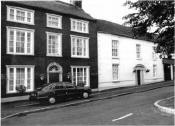 Lutton and had a large family. At the time of marriage they
were both eighteen years of age and there was much
opposition in the family to the marriage. The family were
owners of several estated and private houses with by
purchase or by inheritance in or around Moira. Ralph Lutton
lived in the Main Street, near the present Four Trees Public
House and later on moved to Donaghcloney. He returned to
Moira to another house on the Main Street, opposite the
previous one - (for many years the home of the Uprichard
family). He was a classical scholar and a distinguished
linguist, and had tutored some Curates of Moira Church. He
had also a good voice, fine musical taste, and played well
on the violin, but he was partially blind from cataract.
Incidentally his daughter Anne was also a distinguished
linguist being conversant in over 50 languages. His wife was
a fine, handsome woman, of gracious presence, and very
popular amongst her neighbours and friends. She too
possessed strong literary tastes, but her large family and
partially blind husband left little leisure for their
development. Mrs. Lutton is reputed to have had a cure for
whooping cough due to her close relationship (i.e. cousin)
to her husband. Their daughter Anne was also said to possess
these powers.
Lutton and had a large family. At the time of marriage they
were both eighteen years of age and there was much
opposition in the family to the marriage. The family were
owners of several estated and private houses with by
purchase or by inheritance in or around Moira. Ralph Lutton
lived in the Main Street, near the present Four Trees Public
House and later on moved to Donaghcloney. He returned to
Moira to another house on the Main Street, opposite the
previous one - (for many years the home of the Uprichard
family). He was a classical scholar and a distinguished
linguist, and had tutored some Curates of Moira Church. He
had also a good voice, fine musical taste, and played well
on the violin, but he was partially blind from cataract.
Incidentally his daughter Anne was also a distinguished
linguist being conversant in over 50 languages. His wife was
a fine, handsome woman, of gracious presence, and very
popular amongst her neighbours and friends. She too
possessed strong literary tastes, but her large family and
partially blind husband left little leisure for their
development. Mrs. Lutton is reputed to have had a cure for
whooping cough due to her close relationship (i.e. cousin)
to her husband. Their daughter Anne was also said to possess
these powers.
Anne was the youngest surviving child of a family of
thirteen. She was baptised in 1791 and also confirmed in St.
John's. According to her book the ministry of the clergyman
was limited to Sabbath morning prayers and sermon, and the
services were attended by all the family. The children were
equally well familiarised with the Wesleyan preaching on
Sunday evenings. She claims that by the combination of the two
systems she was preserved from extremes - the arrogant
exclusiveness of High Church prejudices and the contracted
bigotry of hostile sectarianism. Both her parents were
steady adherents of the established Church of England, but
had also joined the Methodist Society. It will be noted that
the Methodist Church originally began as a society within
the Church of England and that both John and Charles Wesley
were originally ordained Church of England clergymen, and
remained as such, and never intended that the Methodists
should become a separate Church. It was after their deaths
because of persecution that the Society became a separate
Church. At an early age Anne Lutton was preaching in
Methodist meetings and on one occasion was denounced by one
of the Moira Curates. She was once asked if she loved the
Church - she said, "I even love the walls and whenever I see
a spire, my heart warms to it." She was very friendly with
the Langtry family who first lived at Kilmore House and
later at Fortwilliam. (This family were related to the
husband of the actress Lily Langtry who became mistress of
King Edward VII). It was on the advice of Miss Langtry she
offered herself for confirmation by the bishop of Dromore,
Dr. Saurin. She exhorted peaceful measures when the Rector
in 1821-Rev. Lewis Saurin, a brother of the Bishop, divided
the Irish Methodists from receiving the Sacrament from
Methodist preachers .... she would have preferred that the
custom which prevailed in Mr. Wesley's day of receiving it
at a church only. In 1882 she penned a tract containing
reasons for preferring the established church to all others.
One of the curates of Moira, Rev. John Oldfield regularly
instructed Anne Lutton in Hebrew and Greek. Mr. Oldfield
later married a Miss Greer of Oakleigh, Lurgan, a good
friend of Miss Lutton. He became Archdeacon of Elphin. Her
book for a large part consists of letters to Miss Langtry
and to Miss Greer. Her family burial ground was at Old
Aghalee. Not long before her death she revisited the family
grave where the sexton showed her the little chapel attached
to the burial ground "which a man called Oliver Cromwell had
blown up with a cannon about six hundred years ago". (The
Cromwellian rebellion had only been about a hundred and
fifty years earlier). When they visited Magheralin, "an old
crone gave us weird stories of apparitions of the Countess
of Moira". Many more towns and villages were visited
including Lurgan, Banbridge, Scarva and Lord Roden's park at
Tollymore, Bryansford. All these were places where she had
conducted meetings fifty-four years earlier.
�Top
|